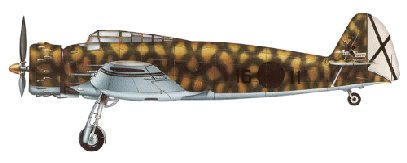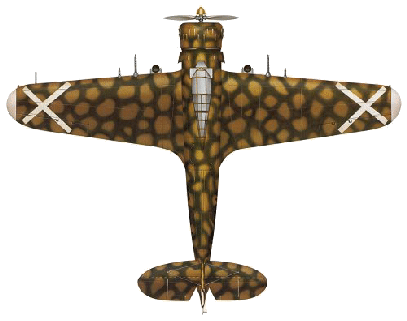Intended as an
aeroplano di combattimento, capable of fulfilling the roles of
interceptor fighter, light bomber, or reconnaissance/attack aircraft as
required, the prototype Breda Ba.65 (MM 325) made its initial flight in
September 1935, piloted by Ambrogio Colombo. It was a cantilever
low-wing monoplane with main landing gear units retracting rearwards
into underwing fairings. Basic structure of the fuselage and wing was
of chrome-molybdenum steel alloy tubing, covered overall with duralumin
sheet, except for the trailing edges of the wing, which were
fabric-covered. The wing incorporated trailing-edge flaps and Handley
Page leading-edge slats. A single fin and rudder tail assembly was
strut- and wire-braced, and was of steel construction with light alloy
skins.

An initial production
order for 81 Ba.65s was placed in 1936, all powered by the French
Gnome-Rhône K-14 engine of 700 hp (522 kW) as had been installed in the
prototype. A batch of 13 aircraft from this production series equipped
the 65a Squadriglia of the Aviazione Legionaria, the Italian air
contingent sent to support the Fascist cause in the Spanish Civil War
.The unit took part in operations at Santander in August 1937, then at
Teruel, and in the battles for the River Ebro. Like the prototype these
were single-seat aircraft, with the pilot's cockpit fully enclosed by a
glazed canopy which tapered to the rear.

A Breda Ba.65 K-14 of the 65th Attack Squadron Aviacion del Tercio
(Nationalist Air Force) - Puig Moreno 1938
Experience in Spain
indicated that the Ba.65 was suited only to the attack role, and the
type served thenceforth with most of the eight squadriglie attached to
the two Regia Aeronautica assault stormi (wings), the 5° and
50°. A second series of 137 aircraft was built by Breda (80) and
Caproni-Vizzola (57), before production ended in July 1939. They
differed from the first production batch by having Fiat A.80 engines.
Six Fiat powered Ba.65s and four more of the Gnome-Rhône powered
version were sent to the Aviazione Legionaria in Spain in 1938.
Following Italy's entry
into World War II in June 1940, Ba.65s were involved in the fighting in
North Africa against the British. They had a low serviceability rate in
desert conditions and put up an unimpressive performance. The last
serviceable aircraft was lost during the British offensive in Cyrenaica
in February 1941.
A large number of the
Ba.65s serving with Italian units were of two-seat configuration, with
an observer/gunner in an open cockpit above the trailing edge of the
wing. A smaller number of the type had a Breda L type turret, but in
either case the observer/gunner operated a single 7.7 mm (0.303 in)
machine-gun. While offensive armament could theoretically comprise up
to 2,205 lbs (1000 kg) of bombs, the load usually carried was up to 661
lbs (300 kg) in the fuselage bomb bay or, alternatively, up to 441 lbs
(200 kg) on underwing racks.
Exports included 25
Fiat powered Ba.65 two-seaters to Iraq in 1938, two of them
dual-control trainers and the remainder with Breda L turrets; 20 Ba.65s
with Piaggio P.XI C.40 engines to Chile later in the same year. 17 of
them single-seaters and three dual-control trainers; and 10 Fiat
powered two-seaters with Breda L turrets to Portugal in November 1939.
A single Fiat powered production aircraft was tested with an American
Pratt & Whitney R-1830 engine in June 1937 in anticipation of an order
from the Chinese Nationalist government, but this failed to
materialise. The Iraqi Ba.65s saw limited action against the British
during the 1941 insurrection in that country.
(Breda Ba.65 A.80)
Type: Single
Seat Ground Attack
Design: Breda
Design Team
Manufacturer:
Societa Italiana Ernesto Breda and also built by Caproni-Vizzola (57)
Powerplant:
(Ba.65 A.80) One 1,000 hp (746 kW) Fiat A.80 RC.41 18-cylinder radial
piston engine. (Ba.65 K-14) One 700 hp (522 kW) Rhone-Gnôme K-14 radial
engine.
Performance:
Maximum speed 267 mph (430 km/h); maximum speed (two-seat) 255 mph (410
km/h); service ceiling 20,670 ft (6300 m).
Range: 342 miles
(550 km) on internal fuel.
Weight: Empty
equipped 5,291 lbs (2400 kg) with a maximum take-off weight of 6,504
lbs (2950 kg).
Dimensions: Span
39 ft 8 1/2 in (12.10 m); length 30 ft 6 1/4 in (9.30 m); height 10 ft
6 in (3.20 m); wing area 252.96 sq ft (23.5 sq m).
Armament: Two
12.7 mm (0.50 in) and two 7.7 mm (0.303 in) Breda-SAFAT fixed forward
firing machine-guns in the wings, plus up to 661 lbs (300 kg) of bombs
in fuselage bomb-bay and up to 441 lbs (200 kg) of bombs on underwing
racks.
Variants: Ba.65
(MM 325 prototype), Ba.65 (single seat), Ba.65 (two seat), Ba.65
(trainer). No official version designations were used since all
aircraft were technically identical, and aircraft were identified
simply by the engine used.
Avionics: None.
History: First
flight September 1935; (first deliveries) 1937.
Operators: Italy
(Regia Aeronautica), Iraq, Portugal, Chile.
